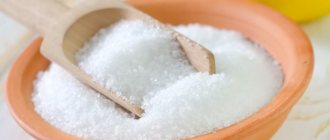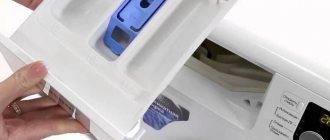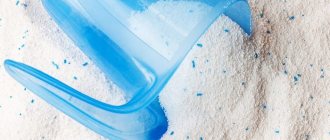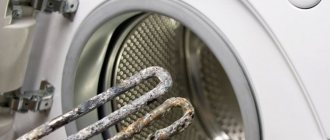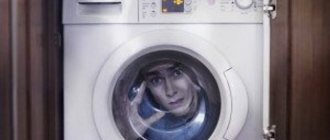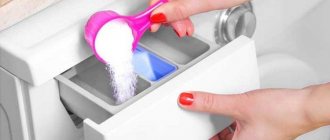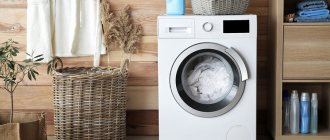The washing machine includes parts made of metal, plastic, glass and rubber. Microorganisms are capable of multiplying on each. In addition, hard water causes scale deposits. All this shortens the service life and degrades the quality of washing. To disinfect a washing machine, you can use traditional methods or ready-made gels, powders, tablets.
Why do you need to disinfect your washing machine?
Disinfection (disinfection) – measures aimed at destroying pathogenic microorganisms, as well as toxic compounds at objects in order to prevent them from getting on the skin and inside the human body.
According to studies, washing clothes, mainly at low temperatures and with gentle detergents, does not lead to the destruction of infectious agents. Bacteria, on the contrary, begin to multiply and spread to other places in the washing machine. It is especially dangerous if they get in and remain on towels, diapers, bed linen, underwear, and other things that come into contact with the body. It is possible that parasites can be transferred from wet underwear to hands and then into the oral cavity.
The appearance of mold is the result of non-compliance with the rules of care for household appliances. Active reproduction of mold fungi is observed at elevated humidity and temperature, which leads to the appearance of dark spots. In addition to the unpleasant odor of washed laundry, mold produces a toxic substance - a mycotoxin, which, when it enters the body, causes a threat:
- irritation and itching - when on the skin;
- cough, shortness of breath - in the respiratory system;
- flatulence, diarrhea, constipation - in the gastrointestinal tract;
- weakening of attention and memory - in nerve cells that enter through the bloodstream.
After each wash, it is necessary to wipe the drum with a clean, dry cloth, remove any remaining moisture from the rubber seal, rinse and wipe dry the detergent tray.
To evaporate excess moisture and prevent unpleasant odors, keep the loading hatch and powder receptacle open for an hour after washing.
It is recommended to disinfect an automatic washing machine at home once every 2-3 months, as well as when mold is detected or foreign odors appear. The procedure involves cleaning the external and internal elements of the device.
Voting by our readers
What would you choose or recommend?
"Dr. Beckmann" for washing machines
50.00 % ( 2 )
"Sandokkaebi" for washing machines
0.00 % ( 0 )
"Magic Power-023" for washing machines
0.00 % ( 0 )
"Topperr 3203" from scale
25.00 % ( 1 )
"Kristall-fix" for large household appliances
0.00 % ( 0 )
"Nagara" for washing machines
25.00 % ( 1 )
"Luxus Professional" for washing machines
0.00 % ( 0 )
Extending the service life of the machine
Manufacturers promise that the machine will last at least 5-7 years. But with skillful handling and compliance with all operating rules, the machine will work even longer. And systematic preventive cleaning must be given paramount importance. But other activities are no less important:
- soften the water with each wash by adding special products;
- carefully check all pockets to prevent small items, paper, and jewelry from getting into the tank and drum;
- do not overload the drum with things, remembering the maximum permissible loading weight;
- for regular washing, choose modes with water heating less than 90 degrees; with frequent use of high-temperature programs, the machine becomes vulnerable to breakdowns;
- use special mesh bags for washing items with metal elements, faded woolen items and shoes;
- control the washing process in order to promptly respond to leaks, uncharacteristic knocking or grinding sounds;
- After each wash, wipe the drum and rubber seal dry;
- leave the hatch door and tray open to ensure free passage of air inside the housing;
- clean the garbage filter at least once a month;
- run an “empty” wash if you do not plan to use the machine in the near future.
Careful handling of electricity is also of particular importance. Thus, it is strictly forbidden to turn off the machine by unplugging the cord from the electrical outlet, otherwise it is easy to damage the control board. Ideally, you should connect a voltage stabilizer to the machine to eliminate voltage drops that adversely affect the unit system.
The presence of dirt, mold and bacteria in an automatic washing machine has a bad effect not only on the quality of washing, but also on the health of its owners. Domestos will allow you to quickly and effectively overcome all accumulated troubles, but only with strict adherence to safety rules.
Cuff
A detail that allows the door to close tightly and prevent water from leaking out. The cuff is moistened with a damp cloth and wiped dry after each wash.
If the elastic band has already become very dirty due to infrequent care, wash it carefully. You should be careful with aggressive detergents: they will damage the elastic.
Washer cuff
How to clean a washing machine with citric acid
To clean limescale in an automatic washing machine designed for 4 kg of laundry, you will need 60 grams of food concentrate. Since the product is sold in small packages, 3-4 packages are enough for one procedure. Excessive use of the substance may cause damage to the unit. How to clean a washing machine with citric acid from scale and eliminate unpleasant odors? Follow the step by step instructions.
How to descale a washing machine with citric acid
To wash your automatic machine from limescale, mold and unpleasant odors, use the following recipe:
- Prepare two bags of lemon juice. Pour it into the special powder compartment.
- Check for foreign objects inside. Don't forget to bend the edges of the elastic.
- Turn on the full program, which runs at the highest temperature possible.
- Program an additional rinse. If there is no such program, then after completing the cycle, repeat the rinsing procedure by pressing the corresponding button.
- When finished, don't forget to wash the inside of the drum. There may be some limescale residue that needs to be removed.
How to clean a drum with citric acid
The first method removes scale well from the heating device of the machine. How to clean the inside of a washing machine with citric acid, since plaque also remains on the drum?
- You should pour the food concentrate inside the drum. Take the quantity no more than 100 grams.
- Set the temperature from 60 to 90 degrees. A lower temperature will not dissolve the substance.
- Start the longest mode. After 10 minutes, stop the program and pause for one hour to allow the concentrate to react with the limescale deposits.
- Then continue the program. If the process is accompanied by a hum, these are split scale particles falling into the drain, which means: the cleaning is successful.
- Upon completion, you need to rinse the unit again, turning on an additional rinse.
The unpleasant odor emanating from the washing machine tank transfers to clean clothes. Calgon saves the machine from scale, but not from mold. Don't buy expensive tablets; run to the store for citric acid.
Important ! Citric acid comes in two types: specialized and household. In industry, a special concentrated liquid is used, the concentration of which is more than 10%
Store-bought lemon juice does not contain more than 3% acid
In industry, a special concentrated liquid is used, the concentration of which is more than 10%. Store-bought lemon juice does not contain more than 3% acid.
Each brand of washing machine has its own structural features. Brands LG and Bosch produce models with very wide rubber bands between the door and the drum.
In which socks often get stuck and things disappear
. The rubber seal of the Samsung is not so wide, but this makes the task more difficult when cleaning.
How to rinse an automatic washing machine with citric acid? You will need about 300 g of food-grade lemon, which you need to pour into a container for the powder. Turn on the children's mode with boiling or set the maximum temperature in the settings.
The main requirements for such cleaning:
- Use citric acid 3%
, which is sold in the grocery supermarket. Not to be confused with lemon juice, which is not useful as a cleanser. - Do not add washing powder
. - Do not wash clothes this way
.
After carrying out the descaling procedure, check for dirty residues in the drain and in the washer drum. At the end of the cycle, add an additional rinse.
This method saves your money and is safe and does not shorten the service life of the assistant.
It is better to observe the nuances when using:
- The method of cleaning the drum with lemon is simple
, but you should not carry out the procedure frequently, as this will affect the spare parts of the washing machine. - If the water in the drum is heated too high
, the temperature sensor can be damaged. - Clean the machine yourself
so that large pieces of scale do not get stuck in the parts of the device.
Cleaning internal elements and heating elements
To clean the drum and electric heater (TEH), you can use ready-made products. They are produced taking into account the design features of household appliances and do not harm human health.
Experts also advise regularly using Calgon water softener in caring for your equipment. This is an effective prevention of scale formation. Calgon does not fight existing contaminants, but prevents the formation of new ones by reducing the concentration of salts in the water. The product is added before turning on the machine: with the powder or in the drum.
What to do if there is so much limescale that chemicals cannot cope with them? Manually descale your machine:
- Study the manufacturer's instructions to understand exactly where the heating element is located.
- Disconnect the wires and sensor and remove the heating element, this can be done using a flat-head screwdriver.
- Plaque can be removed with the hard side of a sponge or fine-grit sandpaper. Avoid using a knife: cleaning the washing machine this way can damage the appliance or leave scratches.
- It is advisable to soak the heating element for a couple of hours or until the morning in a solution of citric acid or vinegar diluted with hot water. This way you will definitely remove all scale and dirt. Then clean the heating element with a toothbrush and rinse with water. Wipe the heating element dry and return it to its original place.
After thoroughly cleaning the inside of the machine, the sharp or rotten smell will disappear, and the quality of the wash will improve. Remember that over time, scale can cause the heating element to overheat, which will eventually burn out. It is better to perform regular preventive cleaning than to spend money on expensive repairs.
Causes of mold in the washing machine
There are many reasons why a washing machine becomes infected with mold. But almost always the owners of the unit are to blame for the increased proliferation of fungus because they do not follow the rules for caring for household appliances.
As mentioned above, mold can grow and multiply rapidly only in appropriate conditions. Ideally, this is 90% humidity and 20 °C temperature. Small deviations from these indicators are also quite acceptable for microscopic fungi.
In the bathroom, the washing machine will always be in a damp, warm atmosphere. If possible, it is better to immediately install the machine in another, drier room
In a person’s home, such conditions are maintained in the bathroom all year round, so installing a washing machine here is extremely undesirable.
For this purpose, a kitchen or hallway is more suitable. If there is no choice and installation is possible only in the bathroom, you should definitely take care of good ventilation.
Moisture remains on the cuff, inside the tank and on other parts of the unit at the end of the washing process of the loaded laundry. She needs to be given time to evaporate, leaving the door open for these purposes.
As a result, drops of water remaining inside the machine after washing create excellent conditions for the life of mold fungi.
At the end of the wash, a certain amount of water almost always remains in the folds of the rubber cuff, which acts as a seal for the door. Gradually it will evaporate, which is guaranteed to provide high humidity inside the machine. This is exactly what mold spores need to grow rapidly.
In order to save energy, owners constantly wash in low-heated water. This is fraught with the fact that the components of the washing machine are not disinfected at high temperatures.
Using programs with modes of 60 °C and above causes the development of fungi to stop and their death. Lower temperatures only promote their development
However, it is not at all necessary to constantly use these detergents. Alternating through 3-4 washes with regular powder is enough.
With modern detergents containing bleach, it is not necessary to wash only pure white laundry. Some colored items will not fade when washed using the above powder.
Another possible cause is improper washing with fabric softener. When washing with conditioner, be sure to run an extra rinse.
If this is not done, again for reasons of economy or simply due to ignorance, particles of rinse aid remain on the door, in the folds of the rubber cuff, on the drum mesh and the walls of the tank. This breeding ground is perfect for mold growth.
Mold in the washing unit can be caused by improper connection to the sewer system. As a result, the water does not drain correctly and some of it remains inside the machine.
Stagnant, dirty water is the best way to promote the development of mold colonies.
To correctly connect the washing machine to the sewerage system, it is advisable to use the manufacturer’s recommendations for self-installation or invite a specialist
The best remedy for pollution is prevention!
General cleaning of a washing machine is a rather troublesome and time-consuming undertaking. Sooner or later, but probably any owner of the device will face the need for it. However, to prevent this from happening too quickly, and from occurring alarmingly often, there are some requirements for the daily care of this device that should be followed. They are simple, but for some reason they are often ignored by careless owners.
Some owners of washing machines do not bother to carefully read the included instructions, limiting themselves only to starting the process and selecting programs. Here is the reason for the rapid “overgrown with dirt” and a decrease in the quality of washing!
Let's quickly go through these simple recommendations:
- The machine must initially be installed correctly, strictly level. This is not a whim - even a slight misalignment can contribute to the creation of stagnant zones in the tank, from where water will not drain. This means that a pocket of dirt and a source of unpleasant odor will soon appear here.
- If the water in the water supply network or in an autonomous source has a high concentration of hardness salts, it must be softened.
— The best option is special ion exchange filters that are guaranteed to bring water hardness to normal.
Water softening with ion exchange columns is especially important if the house is powered by a well. This is important not so much for household appliances, but also for the health of residents.
— Recently, magnetic filters have become widespread. More precisely, these are activators that, through exposure to a magnetic field, promote the crystallization of salts even before contact with the surfaces of the washing machine and heaters. And the insoluble sediment is removed by conventional mechanical filtration even before entering the apparatus.
Magnetic converter of dissolved hardness salts into an insoluble precipitate that can be removed by filtration.
— If nothing else can be done, then you will have to regularly use softening additives, which were already mentioned above.
- The machine must be immediately installed in such a way as to exclude or at least minimize the likelihood of external contamination getting on it - drops of grease or water splashes. If such contamination cannot be avoided, then external cleaning should be carried out with enviable regularity.
- You should try whenever possible to avoid washing at too high temperatures.
- Loaded laundry must be checked for the presence of foreign objects or substances in pockets or folds.
- If you are washing items that are prone to pilling or that saturate the water with fibers (sweaters and other knitted items, blankets, bedspreads, etc.), then you should use special bags with a fine mesh.
It is preferable to wash knitted, woolen and other delicate items in special mesh bags.
- Washed laundry should be removed from the drum immediately. Even a short stay in a closed tank will cause unpleasant odors.
- Any, even the smallest wash should be completed by wiping the wet surfaces of the machine dry, removing accumulated water in the cuff of the loading hatch.
- It is best to keep the hatch ajar. If this is not possible, then at least the tank should be properly ventilated after finishing the next wash.
- The powder and conditioner tray should be washed regularly without prompting.
- Under no circumstances should the washing machine drum serve as a storage area for collecting dirty laundry while waiting to be washed. To do this, you should look for another place.
If you use the tank space as a storage area for dirty laundry waiting to be washed, you are guaranteed an unpleasant smell from the washing machine!
- You should not skimp on the quality of laundry detergents. Cheap powders are a direct path to quickly becoming overgrown with dirt and causing the machine to fail!
- You can put it in your calendar, in the “reminder” program on your phone or computer - if you regularly use your washing machine, find five minutes every two to three months to check and, if necessary, clean the filters.
As you can see, the rules are very simple and, one might say, obvious. The main thing is that nothing prevents you from constantly adhering to them.
Review of professional products
Of the professional disinfection products, the most effective are:
- Dr. Tan Antibacterial;
- Dr. Beckman;
- SANDOKKAEBI;
- Multidez-Teflex.
Dr. Teng Antibacterial
This product allows you to remove scale from your washing machine and disinfect it. Promotes quick and effective removal of lime from the drum and heating element. The product contains no acids, therefore, the elements of the machine, which are made of metal/plastic/rubber, will not break.
Dr. Beckman
The liquid product Doctor Beckman has a bluish color and has a specific odor. It includes:
- tenside neitones;
- flavoring;
- hexylcinnamal.
The cleaner in powder form has a slightly different composition:
- zeolites;
- oxygen-based bleach;
- flavoring;
- limonene;
- hexylcinnamal.
Dr. Beckman provides:
- protection of metal parts of the machine from corrosive effects;
- elimination of large contaminants;
- elimination of mold formations in the drum, heating element, pipeline;
- extension of the operational period.
SANDOKKAEBI
This Korean product allows you to clean the drums of washing machines with vertical/front loading. The product is good at removing hard water deposits. It is sold in half-kilogram packs.
Multidez-Teflex
This disinfectant is made in the Russian Federation. It has an antimicrobial effect and also destroys viruses. On surfaces treated with it, an almost invisible film is formed, which provides a residual antimicrobial effect. Multidez-Teflex does not provoke corrosion of metal parts.
Means for disinfection and disinfection
There are cheap but quite effective means for disinfecting washing machines:
- Lemon acid. Cleans parts automatically without harming them. Its low efficiency is observed in the absence of disinfection of the machine for a long time and the accumulation of a thick coating of salts on its elements. Repeated use of the substance or the choice of another means is required.
- Bleach or other chlorine-containing bleaches. They have an excellent cleansing effect. However, its use can lead to damage to rubber parts: cuffs and gaskets. Therefore, disinfection with white is carried out no more than once a year.
- Soda. It only cleans the walls of the drum; it is not suitable for disinfecting the tank and heating element. Also, its use is only possible for manual cleaning.
- Vinegar. It is an effective product but has a negative effect on rubber parts.
If desired, in hardware stores you can choose industrial products for cleaning washing machines: “Universal Anti-Scaling”, “Kaneyo”, “Nagara” and others.
From what has been written above, we can conclude that disinfecting washing machines does not present any particular difficulties and does not require the invitation of specialists. It can be carried out using inexpensive and accessible means. By cleaning your equipment in a timely manner, you can not only increase its service life, but also avoid health problems.
Are certain types of tissue more susceptible to the virus than others?
How long the virus lasts depends on the fabric, as some materials are more porous than others.
The researchers believe that the fibers in the porous material trap virus particles, dry them and break them apart, and make smooth surfaces such as leather and vinyl easier to clean.
It is believed that synthetic materials like polyester may retain germs longer than breathable cotton-based fabrics, so synthetic outerwear, underwear and dresses should be thoroughly washed.
As information and research related to COVID-19, the disease caused by the coronavirus, continues to evolve, research on it tells us the ability of the virus to remain on surfaces such as cardboard, steel, copper and plastic, door handles and high-traffic areas.
Some viruses can remain active after two to three days on plastic and stainless steel, 24 hours on cardboard and four hours on copper. And most likely, some of the clothing details such as buttons, zippers, etc. can be made from these materials.
Is it permissible to use such a tool?
Many housewives will say that only whitewash, Domestos, ACE and other similar products can cope with stains in the washing machine. But manufacturers do not agree with their opinion and, on the contrary, strongly do not recommend using the mentioned brands for preventive cleaning. The reason for the ban is the presence of chlorine in their composition - an aggressive cleaner that can harm the insides of the machine.
But there is a caveat - only prolonged contact with chlorine is harmful to the machine. Therefore, one-time cleaning with an interval of at least 6 months will not damage even the most vulnerable parts of the machine: rubber gaskets and hoses with pipes. The main thing is to strictly follow the instructions and do not forget about the rules of personal safety. Algorithm for cleaning a machine with Domestos.
- We wear rubber gloves to prevent the product from getting on the skin of your hands.
- Make sure there are no dirty things in the drum.
- Apply the liquid evenly to the drum and the hatch cuff.
- Close the door tightly and do not go near the machine for 20 minutes.
- After 20 minutes, pour another 50 ml of Domestos into the drum and start the machine on the “Rinse” program.
- At the end of the cycle, we repeat the start, choosing a mode with a water heating temperature of over 90 degrees and pouring about 200 grams of dry citric acid into the main compartment of the tray.
- We wipe the drum, cuff, door and powder receptacle dry and leave the machine open for ventilation for at least an hour.
You should wash with Domestos carefully. It is necessary to control the cleaning process, as the machine often begins to crackle quietly
In this case, the machine stops, and the pump, garbage filter and drain hose are thoroughly washed. We must not forget that a strong cleaner will cause the rapid release of hard deposits and scale, which cause blockages and jamming. The main thing is to react in a timely manner, remove them and continue washing.
The effect of the procedure will appear immediately: fungal plaque and unpleasant odor will disappear. The scale will also be removed from the heating element, which will increase the service life of the washing machine for another couple of years. But if your financial situation allows, it is better to choose more expensive and gentle products instead of strong cleaners. Their use is absolutely safe, and the complex result will allow you to get rid of viruses, bacteria, dirt and all the widows of the fungus. The modern market offers many options: disinfecting soft gels Velvet, Vanish and Belle, eliminating mold and scale Doctor Beckman, Doctor TEN Antibacterial and Korean SANDOKKAEBI.
Why do you need to disinfect your washing machine?
There is no doubt about the advisability of disinfecting the machine. Water and powder are in constant contact. This contributes to the appearance of plaque and scale on the internal and external parts of the SMA. Particularly dangerous are places in the washing machine where moisture is constantly present or water remains: in the drum, under the cuff of the loading hatch, in the powder receptacle, in the drain valve filter.
In this case, don’t expect clean and fresh laundry when you leave. It will be saturated with germs and an unpleasant odor that even copious amounts of good powder will not cope with.
Proper care of any automatic machine includes the following procedures:
- washing and systematically wiping dry the outer parts of the SMA;
- washing the drain valve filter;
- disinfection with special antibacterial agents;
- removal of mold and unpleasant odors;
- descaling.
The first procedure on the list must be carried out regularly, the rest - periodically. In order for your equipment to serve properly and for a long time, do not forget about its timely cleaning. Then the above procedures will only be of a preventive nature. They carry out disinfection at home, and there are no difficulties in this. But how to properly disinfect a washing machine, we’ll talk about this further.
Main stages
The washing machine disinfection procedure consists of the following steps:
- external cleaning;
- washing filter elements;
- descaling;
- removal of mold formations and unpleasant odors;
- cleaning from microorganisms.
Washing and removing dirt from the outside
Dry the machine with a soft cloth that absorbs water well. You can use liquid soap as a cleaning agent. Remove any remaining soap solution with clean water. Wipe the device with a dry cloth after cleaning.
See also
Rules for caring for suspended ceilings and the best cleaning products
Washing filters
Unscrew the drain filter, first placing a thick cloth under it. Wash it with heated water. If the dirt is not washed off, place the filter in a glass/plastic container for 3-4 minutes and pour in Domestos.
Descaling
It is possible to remove scale as follows:
- Pour 150 grams of citric acid into the powder compartment.
- Set the longest wash cycle at a temperature of about 92 degrees.
- Start the cycle.
Cleaning from mold and odor
Boiling is a simple and quick method of killing mold and eliminating unpleasant odors. When the water is heated to a temperature close to 100 degrees, the machine will be cleaned of mold formations. Activate the “boil” mode and start the cycle.
Disinfection from germs
It is possible to disinfect the device from germs using any of the following methods:
- Pour 200 grams of citric acid into the powder compartment.
- Pour 350 milliliters of table vinegar into the drum.
- Mix acetic acid in equal proportions with chlorine bleach and pour into the powder compartment.
- Mix 50 grams of soda with 50 milliliters of water, pour the solution into the cuvette. Pour a couple of glasses of vinegar into the drum.
Performing disinfection during washing
Disinfection of washing equipment can also be carried out during washing, since many bacteria and most microorganisms begin to die when the water temperature is 60 degrees. You can, for example, select the “Synthetic 60” or “Cotton 60” washing mode.
Whirlpool machines are equipped with an “Antibacterial” mode. When this mode is turned on, the water temperature rises to 80 degrees. This temperature is maintained for fifteen minutes.
And Miele devices have the “Hygiene-cotton” option. In this mode, the water temperature is 60 degrees for one hour. You can also use the Boil option, which kills the dysentery bacillus.
Machines manufactured by Whirlpool, LG, Daewoo contain a steam option, which also destroys bacteria.
Disinfection of the machine
The component parts of the machine have a favorable climate for the appearance of microbes.
This especially applies to places where water accumulates:
- Compartment for loading conditioners and powder;
- Filter;
- Cuff;
- Tank.
For this reason, you need to clean your washing equipment regularly.
Disinfection of the washing machine contains the following points:
- Cleaning the external parts of the washing machine;
- Destruction of microbes;
- Cleaning filters;
- Cleaning the device from foreign odors;
- Removing scale and mold deposits.
Correct use of cleaning products
Cleaning the outside of the washing machine is done as follows. First of all, you need to dilute a little dishwashing detergent in a large amount of water.
Next, soak a cloth in this solution and wipe the front side of the washing machine with it, paying attention to the hatch door
Then use a dry cloth to wipe the washer dry. Next you need to process the glass of the hatch. A glass cleaner is suitable for these purposes.
The body of the washing machine cannot be cleaned with the following means:
- Dry powders;
- Abrasives;
- Substances containing chlorine.
The drain filter needs to be cleaned at least monthly. This is necessary to ensure that dirty water drains well from the machine. Regular cleaning of the drain filter also prevents unpleasant odors. This element of the machine can be found on the lower front panel of the washing machine. You need to unscrew it counterclockwise.
Before dismantling the filter, place a dry cloth under the device. After all, when you unscrew it, a small amount of water may leak out of the filter. The filter should be cleaned under water pressure using detergent. You can also disinfect it using Domestos.
The powder tray is a breeding ground for bacteria and even mold. Therefore, it must be washed without fail. To remove the tray, you need to press the latch, then gently pull it towards you.
A heavily soiled tray should be soaked in a solution of cleaning agent and water for a couple of hours, then cleaned with a toothbrush. To remove limescale, you need to use soda (calcined or baking soda). Then you can disinfect the tray using Domestos.
It should be noted that the powder receptacle must be cleaned and wiped with a dry cloth after each wash.
The powder receptacle opening must also be cleaned using a sponge and cleaning agent. After cleaning, wipe the tray dry with a cloth.
You can remove mold and remove foreign odors in the machine first with baking soda and then with citric acid. The first product is used to clean the drum of the device. To do this you need to take a soft sponge. Use it to apply lightly moistened soda to the washer drum. The inside of the cuff can be treated in the same way.
The cuff should be pulled apart during cleaning. About an hour after applying the product, you need to clean the washer drum and cuff with a sponge. Then you should rinse well and then wipe dry the cleaned sides of the above parts of the washing machine.
Acetic acid removes odors and kills germs. But after using it, there will be a specific smell in the car. Rinsing with conditioner will help eliminate it.
The most important procedure is to disinfect the washing machine from the inside. It allows you to get rid of viruses, kill all bacteria and destroy fungus. Disinfection of washing equipment can only be done using special means.
These products include chlorine, as well as products made on the basis of chlorine. However, chlorine should only be used in exceptional cases. For example, when you need to overcome a virus or infection. In other cases, it is recommended to use other, more delicate methods of disinfection.
For example, you can use various oxygen-containing bleaches:
- Vanish;
- Velvet;
- Belle;
- Synergetic.
These products have disinfectant properties. You need to add bleach during normal washing.
To clean parts from scale, rid them of mold and defeat bacteria, you must use:
- Dr. Beckman;
- Cleaning agent SANDOKKAEBI;
- Means Doctor TEN Antibacterial.
Drain filter
It allows dirt to pass through after washing. Dirty water, detergent residues, small objects, hair, and fabric fibers get here. Therefore, the drain filter periodically becomes clogged.
It is easy to clean. You need to find the cover at the very bottom on the front wall, open it, and unscrew the filter. You should prepare in advance: place a rag or flat container into which the remaining water will drain. The unscrewed filter is cleaned of dirt, washed under running water, and then returned to its place.
Do you turn off the water tap after washing?
Oh yes! No.
Detergent compartment
With each wash, the tray for powder and conditioner becomes covered with a coating of mineral salts present in hard tap water and residues of liquid and powder detergents. It is difficult to wash the tray in a washing machine, so you need to remove it and soak it for 1-2 hours in soapy water, but better in a concentrated solution of Domestos or a similar disinfectant. When all deposits and growths have left the plastic, the tray can be rinsed with running water, and the most difficult areas can be rubbed with an unnecessary hard-bristled toothbrush. The hole under the tray must be cleaned, because there are also particles of dirt, water and detergents there, which will become a breeding ground for microbes.
Frame
To maintain cleanliness, the body of the machine should be periodically washed with a soft cloth soaked in a soapy solution, or simply in water with the addition of dishwashing detergent.
After this, rinse with clean water and dry thoroughly. A microfiber cloth is best for this, as it absorbs moisture fairly quickly.
The glass sunroof should be washed with glass cleaner, as it does not leave streaks and gives a very pleasant aroma. Do not use abrasive products. After such treatment, scratches may remain in which dirt will accumulate.
How to make a comfortable hammock for a cat using improvised materials: he will be delighted
Smart Clothing: Ingenious Tricks to Save Significant Time
The Bank of Russia announced the release of banknotes of a new design
Does washing clothes kill viruses such as coronavirus?
This is a difficult question because the technically correct answer can be misleading.
The following definitions are proposed for “cleaning” and “disinfection”:
- Cleaning refers to the removal of germs, dirt, and contaminants from surfaces. Cleaning doesn't kill germs, it removes them, reducing the number and risk of infection spreading.
- Disinfection refers to the use of chemicals to kill germs on a surface. This process does not necessarily clean dirty surfaces or remove germs, but by killing germs on the surface after cleaning, it can further reduce the risk of spreading infection.
Cleaning the tap water filter and hose
A dirty filter does not allow sufficient water to flow into the device, so the equipment will not be able to function normally. For the cleaning procedure, you need to turn off the tap where the water comes from and unscrew the supply hose. This element is usually located on the back surface of the device in the upper part. As a rule, additional tools for unscrewing are not needed.
There may be residual water in the hose, so it is advisable to place a basin at the work site. After unscrewing the supply hose from the equipment nozzle, remove the filter mesh, then rinse it under water and wipe with a dry cloth. An ordinary toothbrush may be useful for cleaning.
Attention! Usually, to clean the tap water filter, the device is moved away from the wall. After removing dirt and screwing the supply hose, turn on the water and make sure that the connection is tight. If the unit is dry, then everything is in order, you can safely operate the equipment. If water is leaking, turn off the water supply and make sure that you have installed all the elements correctly. Pay attention to the sealing gasket. If it has lost its elasticity, this element will need to be replaced. Has the ring moved? Correct its position, reconnect all components and check the tightness again.
